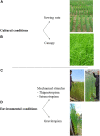Flax (Linum usitatissimum L.) Fibers for Composite Reinforcement: Exploring the Link Between Plant Growth, Cell Walls Development, and Fiber Properties
- PMID: 31001310
- PMCID: PMC6456768
- DOI: 10.3389/fpls.2019.00411
Flax (Linum usitatissimum L.) Fibers for Composite Reinforcement: Exploring the Link Between Plant Growth, Cell Walls Development, and Fiber Properties
Abstract
Due to the combination of high mechanical performances and plant-based origin, flax fibers are interesting reinforcement for environmentally friendly composite materials. An increasing amount of research articles and reviews focuses on the processing and properties of flax-based products, without taking into account the original key role of flax fibers, namely, reinforcement elements of the flax stem (Linum usitatissimum L.). The ontogeny of the plant, scattering of fiber properties along the plant, or the plant growth conditions are rarely considered. Conversely, exploring the development of flax fibers and parameters influencing the plant mechanical properties (at the whole plant or fiber scale) could be an interesting way to control and/or optimize fiber performances, and to a greater extent, flax fiber-based products. The first part of the present review synthesized the general knowledge about the growth stages of flax plants and the internal organization of the stem biological tissues. Additionally, key findings regarding the development of its fibers, from elongation to thickening, are reviewed to offer a piece of explanation of the uncommon morphological properties of flax fibers. Then, the slenderness of flax is illustrated by comparison of data given in scientific research on herbaceous plants and woody ones. In the second section, a state of the art of the varietal selection of several main industrial crops is given. This section includes the different selection criteria as well as an overview of their impact on plant characteristics. A particular interest is given to the lodging resistance and the understanding of this undesired phenomenon. The third section reviews the influence of the cultural conditions, including seedling rate and its relation with the wind in a plant canopy, as well as the impact of main tropisms (namely, thigmotropism, seismotropism, and gravitropism) on the stem and fiber characteristics. This section illustrates the mechanisms of plant adaptation, and how the environment can modify the plant biomechanical properties. Finally, this review asks botanists, breeders, and farmers' knowledge toward the selection of potential flax varieties dedicated to composite applications, through optimized fiber performances. All along the paper, both fibers morphology and mechanical properties are discussed, in constant link with their use for composite materials reinforcement.
Keywords: biomechanics; breeding; cell wall; fiber crops; flax fiber; growth conditions; plant development.
Figures











Similar articles
-
Development of gravitropic response: unusual behavior of flax phloem G-fibers.Protoplasma. 2017 Mar;254(2):749-762. doi: 10.1007/s00709-016-0985-8. Epub 2016 Jun 4. Protoplasma. 2017. PMID: 27263083
-
Rearrangement of the Cellulose-Enriched Cell Wall in Flax Phloem Fibers over the Course of the Gravitropic Reaction.Int J Mol Sci. 2020 Jul 27;21(15):5322. doi: 10.3390/ijms21155322. Int J Mol Sci. 2020. PMID: 32727025 Free PMC article.
-
Expression of auxin transporter genes in flax (Linum usitatissimum) fibers during gravity response.Vavilovskii Zhurnal Genet Selektsii. 2024 Feb;28(1):33-43. doi: 10.18699/VJGB-24-05. Vavilovskii Zhurnal Genet Selektsii. 2024. PMID: 38465245 Free PMC article.
-
Overview and Management of the Most Common Eukaryotic Diseases of Flax (Linum usitatissimum).Plants (Basel). 2023 Jul 28;12(15):2811. doi: 10.3390/plants12152811. Plants (Basel). 2023. PMID: 37570965 Free PMC article. Review.
-
Flax (Linum usitatissimum L.): A Potential Candidate for Phytoremediation? Biological and Economical Points of View.Plants (Basel). 2020 Apr 13;9(4):496. doi: 10.3390/plants9040496. Plants (Basel). 2020. PMID: 32294947 Free PMC article. Review.
Cited by
-
Genes Associated with the Flax Plant Type (Oil or Fiber) Identified Based on Genome and Transcriptome Sequencing Data.Plants (Basel). 2021 Nov 28;10(12):2616. doi: 10.3390/plants10122616. Plants (Basel). 2021. PMID: 34961087 Free PMC article.
-
Reintroducing Flax (Linum usitatissimum L.) to the Mediterranean Basin: The Importance of Nitrogen Fertilization.Plants (Basel). 2021 Aug 24;10(9):1758. doi: 10.3390/plants10091758. Plants (Basel). 2021. PMID: 34579291 Free PMC article.
-
Genetic Architecture of Powdery Mildew Resistance Revealed by a Genome-Wide Association Study of a Worldwide Collection of Flax (Linum usitatissimum L.).Front Plant Sci. 2022 Jun 24;13:871633. doi: 10.3389/fpls.2022.871633. eCollection 2022. Front Plant Sci. 2022. PMID: 35812909 Free PMC article.
-
Gene Expression Analysis of Different Organs and Identification of AP2 Transcription Factors in Flax (Linum usitatissimum L.).Plants (Basel). 2023 Sep 13;12(18):3260. doi: 10.3390/plants12183260. Plants (Basel). 2023. PMID: 37765422 Free PMC article.
-
A Substantial Role of Agro-Textiles in Agricultural Applications.Front Plant Sci. 2022 Jun 21;13:895740. doi: 10.3389/fpls.2022.895740. eCollection 2022. Front Plant Sci. 2022. PMID: 35800605 Free PMC article. Review.
References
-
- Åkesson D., Skrifvars M., Seppälä J., Turunen M. (2011). Thermoset lactic acid-based resin as a matrix for flax fibers. J. Appl. Polym. Sci. 119 3004–3009. 10.1002/app.33030 - DOI
-
- Aldaba V. C. (1927). The structure and development of the cell wall in plants I. Bast fibers of Boehmeria and Linum. Am. J. Bot. 14 16–24. 10.2307/2435518 - DOI
-
- Alix S., Goimard J., Morvan C., Baley C., Schols H. A., Visser R. G. F., et al. (2009). “Influence of pectin structure on the mechanical properties of flax fibres: a comparison between linseed-winter variety (Oliver) and a fibre-spring variety of flax,” in Pectins and Pectinases eds Schols H. A., Visser R. G. F., Voragen A. G. J. (Wageningen: Wageningen Academic Publishers; ) 85–96. 10.3920/978-90-8686-677-9 - DOI
Publication types
LinkOut - more resources
Full Text Sources

